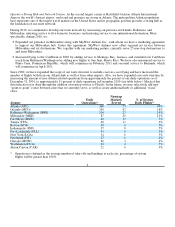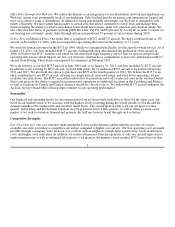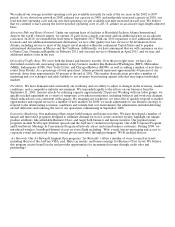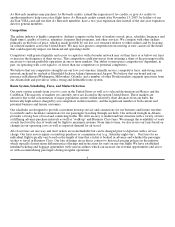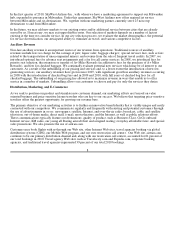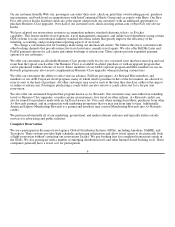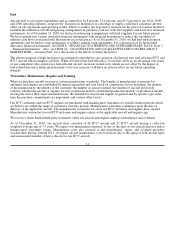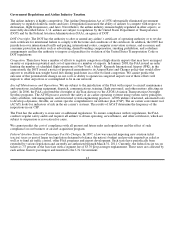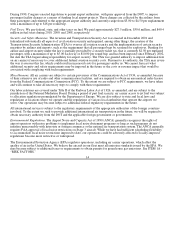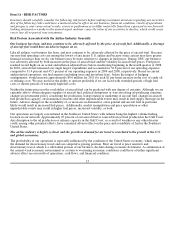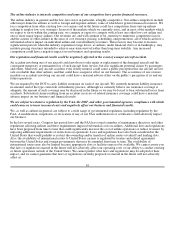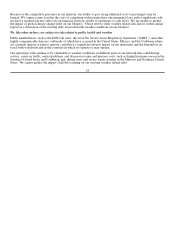Airtran 2010 Annual Report Download - page 18
Download and view the complete annual report
Please find page 18 of the 2010 Airtran annual report below. You can navigate through the pages in the report by either clicking on the pages listed below, or by using the keyword search tool below to find specific information within the annual report.
Employees
As of December 31, 2010, we employed approximately 8,330 employees, equivalent to approximately 7,992 full-time
equivalents.
Both initial and recurrent training are provided for all employee groups. The average training period for new employees
ranges from approximately one to eight weeks depending on job classification. Both pilot and mechanic training are
provided by in-house training instructors.
Federal Aviation Administration (FAA) regulations require pilots to have commercial licenses with specific ratings for the
aircraft to be flown, and to be medically certified as physically fit to fly. FAA and medical certifications are subject to
periodic renewal requirements including recurrent training and recent flying experience. In December 2007, federal
legislation was enacted increasing the mandatory retirement age for U.S. commercial airline pilots from age 60 to age 65.
Mechanics, quality-control inspectors, and flight dispatchers must be certificated and qualified for specific aircraft. Flight
attendants must have initial and periodic competency training and qualification. Training programs are subject to approval
and monitoring by the FAA. Management personnel directly involved in the supervision of flight operations, training,
maintenance, and aircraft inspection must also meet experience standards prescribed by FAA regulations. All safety-
sensitive employees are subject to pre-employment, random, and post-accident drug testing.
We have seven crafts or classes of employees that are represented by labor unions and are covered by collective
bargaining agreements. The Railway Labor Act governs our relations with these labor organizations. The agreement with
our dispatchers, who are represented by the Transport Workers Union (TWU), was ratified in February 2010 and becomes
amendable in March 2014. The agreement with our pilots, who are represented by the Air Line Pilots Association
(ALPA), as successor by merger to the National Pilots Association (NPA), was ratified in November 2010, became
effective December 1, 2010, and becomes amendable in December 2015.
We have four separate agreements with employee groups represented by the International Brotherhood of Teamsters
(IBT). Our agreement with our maintenance technicians and inspectors was ratified in October 2009 and becomes
amendable in October 2013. The agreement with our technical training instructors was ratified in March 2010 and
becomes amendable in March 2015. The agreement with our stock clerks was ratified in June 2006 and becomes
amendable in June 2011. Our agreement with our ground service mechanic employees was effective September 2006 and
becomes amendable in September 2011. We have a collective bargaining agreement with our flight attendants who are
represented by the Association of Flight Attendants (AFA). Our agreement with the flight attendants was ratified in June
2005 and became amendable December 1, 2008. Negotiations regarding proposed amendments to the flight attendants’
collective bargaining agreement are currently in mediation under the auspices of the National Mediation Board.
We also have many employees who are not represented by labor unions. Our customer service, ramp and reservations
agents are not represented by labor unions and have rejected unionization by a substantial margin three times in the past
eleven years. In December 2009, the National Mediation Board (NMB) dismissed an election petition for lack of a
sufficient showing of interest and issued a one year election bar. In December 2010, the International Association of
Machinists (IAM) filed a new election petition with the NMB. At this time there is no determination by the NMB
regarding the sufficiency of this petition. We are unable to predict whether any of our non-union employee groups will
elect to be represented by a labor union or become covered by a collective bargaining agreement in the future. The
election of a bargaining representative could result in employee compensation and/or working condition demands that
could impact our operating performance and expenses.
10






